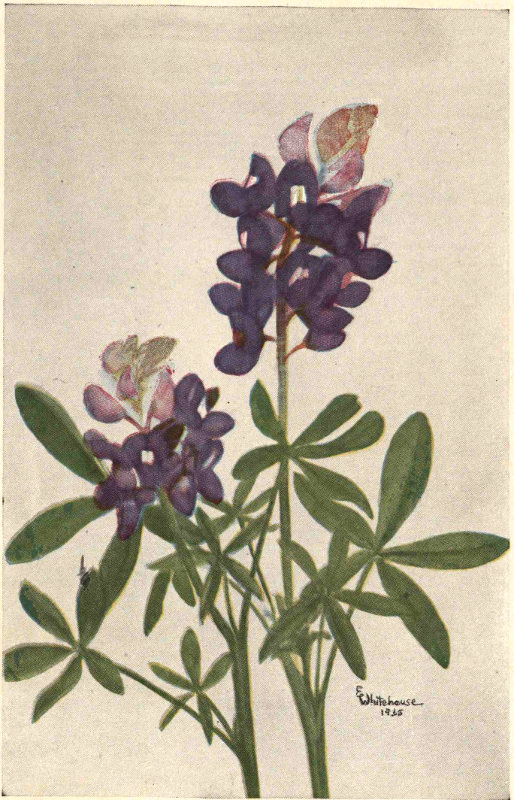

TEXAS BLUEBONNET
THE STATE FLOWER
TEXAS FLOWERS
IN
NATURAL COLORS
BY
EULA WHITEHOUSE
Illustrations by the Author
Published by
EULA WHITEHOUSE
Dallas, Texas
Copyright 1936 and 1948, by
Eula Whitehouse
Box 739, Southern Methodist University
Dallas 5, Texas
Printed and bound in the United States of America
First Edition 1936
Second Edition 1948
TEXAS WILDFLOWERS
From the pine woods to the prairies,
From the Panhandle to the sea,
You’ll find the Texas wildflowers
In marvelous carpetry.
Such magic tints of colors,
Pale pinks and dainty blues,
No artist’s palette can match them
In all their radiant hues.
The Texas sun has kissed them;
To Heaven they lift their eyes;
Beauty and Peace it brings them,
And Freedom under Texas skies.
—Gertrude Whitehouse
PREFACE
For more than a century the wild flowers of Texas have been asource of study and pleasure to scientists and flower lovers. Thestate can boast of a varied and interesting flora which has attractednumerous plant collectors since the first specimens were collected inthe Texas Panhandle by Dr. Edwin James, naturalist accompanyingthe Long Expedition in 1820. Dr. Louis Berlandier, a French botanist,endured the hardships of the Teran Expedition for the explorationof the boundary region between Texas and Mexico between1826 and 1834 in order to collect plants in Texas.
Berlandier’s first collection was instrumental, a few years later,in arousing the interest of Thomas Drummond, a Scotch botanistand collector. In 1833-34 Drummond visited Southeast Texas andcollected 700 species of plants. In 1836, Ferdinand Lindheimer, aGerman botanist, moved to Texas and began his noteworthy studyand collection of Texas plants. Charles Wright, a Yale graduate,came to Texas in 1837, first collecting plants in East Texas and latermaking important additions in Southwest Texas. Since the work ofthese early pioneers, many scientists have visited nearly all parts ofthe state and have added many new names to the list of nativeplants.
Today nearly five thousand species of flowering plants have beenreported from the state. About half of these have showy, conspicuousflowers, and many of them are very limited in their distributionin Texas. If the reader will keep these figures in mind, perhaps hewill not be disappointed at not finding some of his favorite flowers inthe following pages. As such a limited number could be included, itwas thought best to use those widely distributed throughout thestate, omitting some of the well-known plants which have been frequentlyillustrated in previous publications.
The present manual is not intended as a guide to the flora of thestate, but it is ho